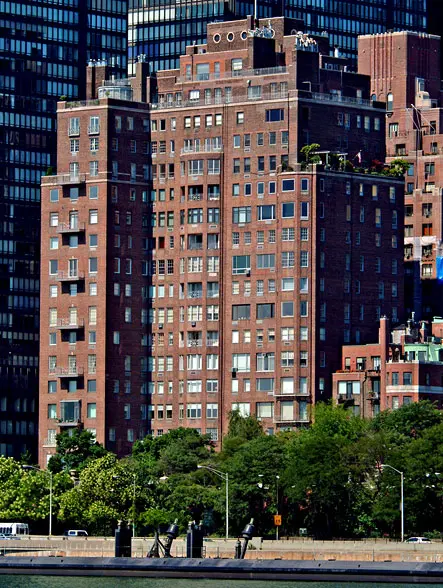1 Beekman Place: Review and Ratings
at The Southeast corner of Mitchell place View Full Building Profile


The most prestigious Beekman Place apartment building is, appropriately, One Beekman Place, which was designed by Sloan & Robertson and Corbett, Harrison & MacMurray and completed in 1929.
While it presents a pleasant and handsome west façade, it gives no hint of the complex and very impressive façade facing the East River.
There, it presents an asymmetrical mass of balconies and bay windows that is not beautiful but as awesome as any castle's battlements.
It would soon be followed by another residential colossus, the River House, a few blocks to the north along the river and both originally had waterfront facilities until the construction of the FDR Drive.
At the time of their construction, the area still contained many tenements and a famous play that was later made into a movie, "Dead End," used the juxtaposition of a super luxury apartment tower with low-income buildings nearby at such a location to evocatively contrast their different worlds and values.
Beekman Place is now filled with other apartment buildings and many attractive townhouses and is considered one of the city's most desirable enclaves because of its quiet, river views and convenience to midtown.
Two decades after this building was erected, the United Nations complex was completed and this building had very impressive views of it from its south façade until the subsequent construction of the large twin-towered luxury apartment and office building known as 860 and 870 United Nations Plaza.
In their book, "New York 1930, Architecture and Urbanism Between The Two World Wars," (Rizzoli International, 1987), Robert A. M. Stern, Gregory Gilmartin and Thomas Mellins noted that this building's "severely detailed exterior sheltered lavishly planned duplex suites with loggias and balconies jutting out over the river."
"An elaborate club facility that included an indoor swimming pool occupied the lower floors and opened onto a waterfront terrace," they added.
The 16-story structure was built as a cooperative in 1929 and originally had 24 apartments, many of them duplexes..
It has a garden, a garage, a fitness center, a pool and a basketball court. It has a doorman and an elevator man.
Its entrance is particularly grand with a three-and-a-half-story high masonry entrance surround enclosing a three-story stone surround and the broken pediment entrance with curved, rising masonry walls.
Beekman Place was named after the Beekman family and Nathan Hale was tried as a spy in the family's mansion, Mount Pleasant, where President George Washington was a frequent visitor. The mansion was demolished in 1874.
This building was erected by a group headed by David Milton, husband of Abby Rockefeller and son-in-law of John D. Rockefeller Jr. Early residents included John D. Rockefeller III, David K. E. Bruce, William J. "Wild Bill" Donovan of the O.S.S., Huntington Hartford, Henryk de Kwiatkowksi, Stavros Niarchos, and Mark Goodman.

 6sqft delivers the latest on real estate, architecture, and design, straight from New York City.
6sqft delivers the latest on real estate, architecture, and design, straight from New York City.
